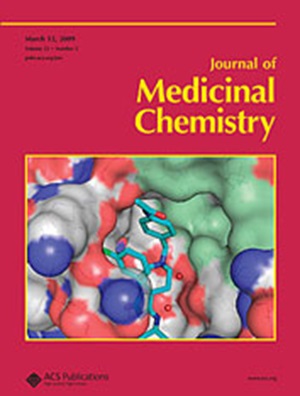Design, Synthesis, Evaluation, and SAR of 5-Phenylisoindoline Derivatives, a Potent Class of Small-Molecule Inhibitors Targeting the Programmed Cell Death-1/Programmed Cell Death-Ligand 1 (PD-1/PD-L1) Interaction
IF 6.8
1区 医学
Q1 CHEMISTRY, MEDICINAL
引用次数: 0
Abstract
A novel series of 5-phenylisoindoline derivatives were designed, synthesized, and evaluated for their activity to inhibit the interaction of PD-1/PD-L1 through the homogeneous time-resolved fluorescence assay. Meanwhile, structure-activity relationships were discussed according to both experiments and calculations. Several compounds exhibited potent activity with an IC50 value less than 10 nM, especially D6 (4.8 nM). D6 could promote IFN-γ secretion and reduce the proportion of PD-L1 late apoptosis at 100 nM in the coculture model of peripheral blood mononuclear cells and hPD-L1-FC. Beyond this, the in vitro model showed D6 could lead to the weakening of migration caused by the PD-1/PD-L1 axis. Furthermore, D6 also displayed dose-dependent and low-toxic efficacy in the MC38 mouse tumor model with the tumor growth inhibition of 52.8% (20 mg/kg, ip) and 64.4% (160 mg/kg, i.g.). Mechanistic investigations suggested that D6 could activate the immune microenvironment in the tumor. Thus, D6 is a promising small molecule lead for blocking PD-1/PD-L1.

本研究设计、合成了一系列新型 5-苯基异吲哚啉衍生物,并通过均相时间分辨荧光测定法评价了其抑制 PD-1/PD-L1 相互作用的活性。同时,根据实验和计算讨论了结构-活性关系。几个化合物表现出强活性,IC50值小于10 nM,尤其是D6(4.8 nM)。在外周血单核细胞和 hPD-L1-FC 的共培养模型中,D6 在 100 nM 的浓度下可促进 IFN-γ 的分泌并降低 PD-L1 晚期凋亡的比例。除此之外,体外模型显示 D6 还能导致 PD-1/PD-L1 轴引起的迁移减弱。此外,D6在MC38小鼠肿瘤模型中也显示出剂量依赖性和低毒性的疗效,对肿瘤生长的抑制率分别为52.8%(20 mg/kg, ip)和64.4%(160 mg/kg, i.g.)。机理研究表明,D6 可激活肿瘤的免疫微环境。因此,D6是一种有望阻断PD-1/PD-L1的小分子先导药物。
本文章由计算机程序翻译,如有差异,请以英文原文为准。
求助全文
约1分钟内获得全文
求助全文
来源期刊

Journal of Medicinal Chemistry
医学-医药化学
CiteScore
4.00
自引率
11.00%
发文量
804
审稿时长
1.9 months
期刊介绍:
The Journal of Medicinal Chemistry is a prestigious biweekly peer-reviewed publication that focuses on the multifaceted field of medicinal chemistry. Since its inception in 1959 as the Journal of Medicinal and Pharmaceutical Chemistry, it has evolved to become a cornerstone in the dissemination of research findings related to the design, synthesis, and development of therapeutic agents.
The Journal of Medicinal Chemistry is recognized for its significant impact in the scientific community, as evidenced by its 2022 impact factor of 7.3. This metric reflects the journal's influence and the importance of its content in shaping the future of drug discovery and development. The journal serves as a vital resource for chemists, pharmacologists, and other researchers interested in the molecular mechanisms of drug action and the optimization of therapeutic compounds.
 求助内容:
求助内容: 应助结果提醒方式:
应助结果提醒方式:


